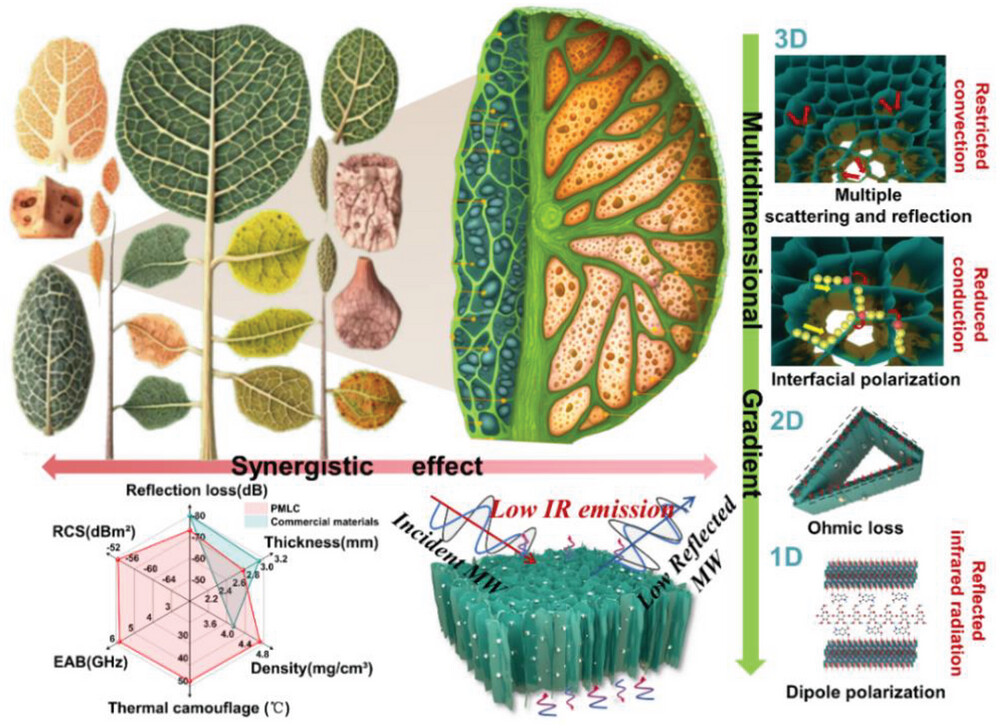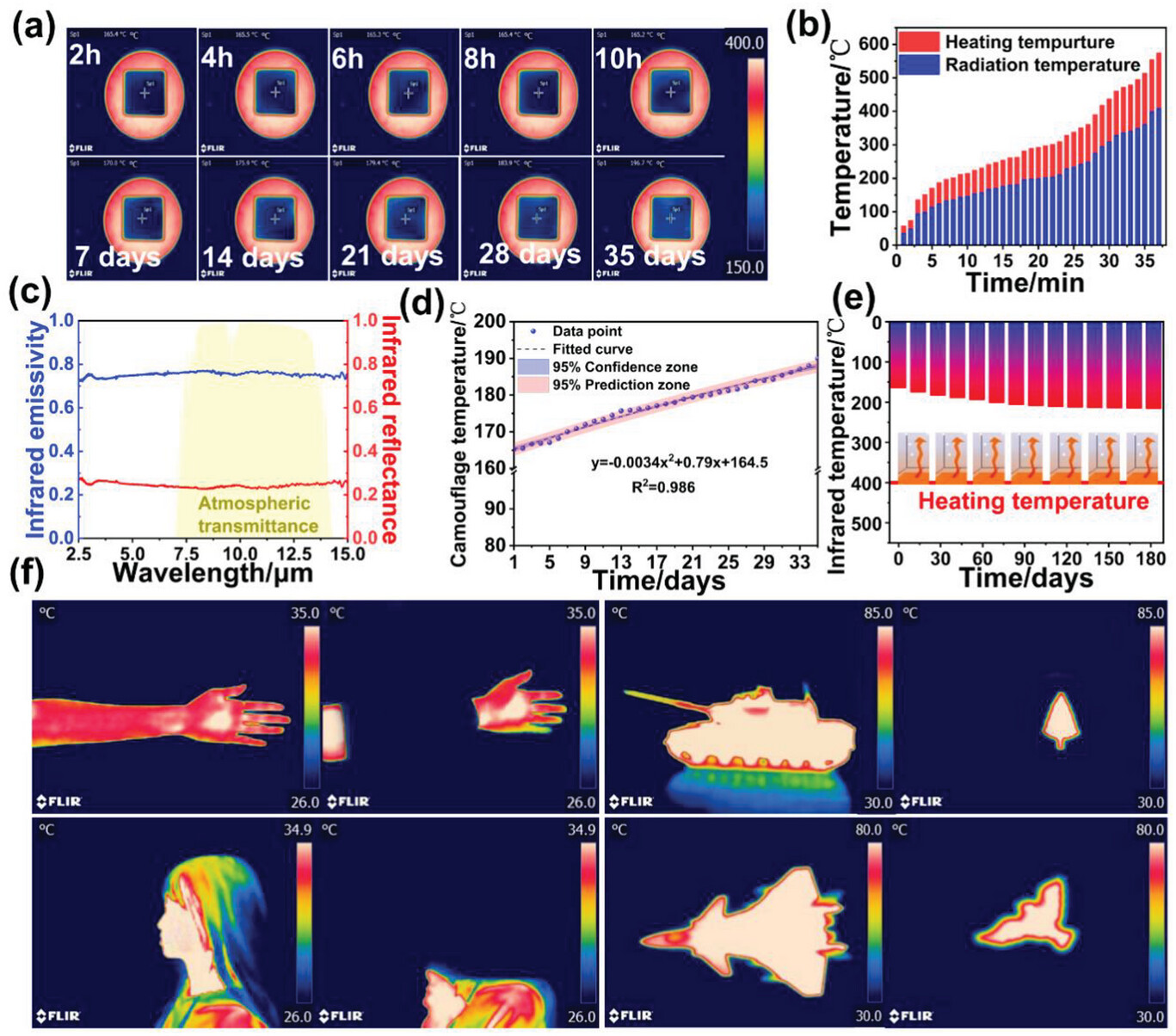| Nov 29, 2023 | |
Liquid metal-MXene-based hierarchical aerogel enables infrared and radar invisibility |
|
| (Nanowerk Spotlight) Researchers have long sought to develop multifunctional stealth materials capable of evading detection across different parts of the electromagnetic spectrum. However, achieving compatible stealth performance across varying radar, infrared, and other bands has persisted as a major challenge. Materials and coatings optimized for radar absorbance often perform poorly for infrared concealment, while infrared-stealth layers may lack radar-wave attenuation. This incompatibility stems from the distinct absorption mechanisms involved across different wavelengths. | |
| Recent work led by researchers at Jiangsu University of Science and Technology demonstrates a breakthrough tunable stealth material design able to provide adjustable radar absorption and infrared thermal camouflage from a single lightweight aerogel structure. Inspired by the multilayered architecture of plant leaves, the researchers developed a bionic scaffold by synergistically combining one-dimensional cellulose fibers, two-dimensional MXene sheets, and liquid metal microspheres. | |
| The work has been published in Advanced Functional Materials ("Liquid Metal-MXene-Based Hierarchical Aerogel with Radar-Infrared Compatible Camouflage"). | |
| The resulting biomimetic configuration resembles the epidermis, vascular bundles, and thylakoid structures found in foliage. It exhibits a hierarchical porous morphology with interconnected voids spanning from its surface through the interior bulk. This complex structural arrangement facilitates excellent impedance matching and establishes extended electromagnetic wave propagation paths to enable strong wideband absorption. | |
 |
|
| Pictorial description of compatible camouflage mechanisms existing in the hierarchical aerogel incorporating liquid metal-MXene components (PMLC). (The area within the hexagon indicator represents the range of parameter values that can be achieved for each indicator). (Reprinted with permission by Wiley-VCH Verlag) | |
| Remarkably, simply by tuning the proportion of constituents, the permittivity, absorption intensity, bandwidth, and wavelength selectivity can be readily modified. The immense interfacial area from the heterogeneous components promotes pronounced polarization phenomena to dissipate impinging radiation into heat. | |
| Optimization yielded maximum radar reflection losses up to 73 dB across a 7 GHz range at just 2.77 mm thickness – significantly outperforming existing market stealth solutions. Durability testing further revealed the material maintains a 60% infrared camouflage efficiency even after 6 months of continuous 400 °C exposure. | |
| The researchers posit the long-term thermal concealment arises from enhanced oxidation resistance imparted by a protective dopamine coating on the MXene flakes. This coating strengthens interfacial binding and reduces structural degradation at high temperatures. Multiscale channels throughout the bionic aerogel morphology also assist convective heat dissipation. | |
| Remarkably, varying the architecture of samples enabled both macro- and micro-scale camouflage applications. Small material segments effectively obscured infrared signatures of objects ranging from human extremities to entire aircraft fuselages. Meanwhile, samples machined into particular shapes provided camouflage against visual detection. For instance, an etched aerogel sheet resembled foliage when placed atop a simulated tank. | |
| The excellent electromagnetic wave absorbance even proved highly effective under simulated operating conditions on a model aircraft airframe across sweep angles from 0 to 180 degrees. According to simulations, radar cross sections decreased by over 50 dBm2 compared to an uncoated equivalent frame. This unprecedented adjustable stealth performance holds promise for enabling a new generation of radar-evading and infrared-concealing defense technologies. | |
| In light of the persistent challenges impeding multifunctional stealth materials, this research signifies an important leap forward. The bioinspired heterogeneous design paradigm sidesteps longstanding limitations of existing approaches reliant on multilayer composites or electronically tuned metamaterials. Importantly, the facile processing empowers rapid iterative prototyping to identify optimized configurations. | |
| By harnessing the synergies between the constituents’ characteristics, a single multipurpose aerogel structure attained functionality rivaling far more intricate structures. This greatly enhances technological readiness for transitioning such biomimetic materials from the lab towards defense applications. Although the radar and infrared stealth capabilities currently serve a military focus, the novel materials configuration could eventually expand towards benefiting civilian domains as well. | |
 |
|
| The thermal camouflage performance. a)Thermal image of PMLC samples on a graphite plate at 400 °C for 10 hours and how it changed when left for 5 weeks, b)Performance change for each day for five weeks, c)Infrared emissivity of PMLC, d)Performance attenuation coefficient fitting curve, e)Radiation temperature of the sample when the temperature gradient changes, f)Placing PMLC samples on a human arm, head and on simulated operating fighter jets and the tanks exhibit excellent thermal camouflage performance. (Reprinted with permission by Wiley-VCH Verlag) | |
| With further development, tunable permittivity stealth materials may find versatile roles ranging from shielding sensitive electronics to visually cloaking buildings or vehicles. Optimization for commercial wireless infrastructure could even yield energy efficiency improvements. Some experts speculate that the eventual transition towards higher frequency networks for 6G and beyond could likewise incentivize such radar-wave engineered materials to mitigate interference issues. | |
| In the nearer term, the most disruptive battlefield impacts may arise from smaller-scale infrared camouflage enabling covert operations. Where previous generations of specialized suits proved bulky and inconvenient, a malleable concealment layer could cloak wore by special forces to evade night vision or thermal detection. Mounted panels similarly promise to hide critical infrastructure from aerial thermal surveillance. | |
| However, the technology’s offensive applications warrant caution as well. Adversaries equipped with such tunable stealth materials could pose unprecedented risks of infiltration and strategic deception. The researchers rightfully avoided speculating on the technology’s potential weapons development roles. Nonetheless, the public should remain cognizant that any significantly advanced stealth capability includes inherent dual-use potential for empowering either defense or aggression. | |
| Governance measures may eventually become necessary to balance equipping defenses against unconstrained proliferation. International discussions already ongoing for emerging technologies like artificial intelligence may offer productive templates to guide policy developments in this sphere as well. And some precedents for governance norms around stealth engineering have emerged in contexts like submarine detection system transparency pacts. | |
| But in the present, savvy regulation appears premature given the early stages of adjusting multifunctional stealth materials. Continuing rapid technical iterations can bring benefits before worrying about restrictions. Nearer-term ethical diligence and public awareness should simply focus scrutiny on whatever defense systems integrate the technology to ensure their employment aligns with humanitarian values and international law. | |
| With so much future promise along with risks, the researchers’ breakthrough represents a technological inflection point. Their tunable radar-infrared aerogel kicks open the doors on a new paradigm for stealth engineering just as earlier innovations like radar absorbent material transformed military contests in their era. The technology’s eventual impacts remain uncertain. But the breakthrough undeniably expands the boundaries of what becomes possible in concealment capabilities. By overcoming longstanding barriers to multifunctional stealth materials, this bioinspired advance furnishes a foundation for other groups to build upon with further progress towards practical defense applications. | |
 By
Michael
Berger
– Michael is author of three books by the Royal Society of Chemistry:
Nano-Society: Pushing the Boundaries of Technology,
Nanotechnology: The Future is Tiny, and
Nanoengineering: The Skills and Tools Making Technology Invisible
Copyright ©
Nanowerk LLC
By
Michael
Berger
– Michael is author of three books by the Royal Society of Chemistry:
Nano-Society: Pushing the Boundaries of Technology,
Nanotechnology: The Future is Tiny, and
Nanoengineering: The Skills and Tools Making Technology Invisible
Copyright ©
Nanowerk LLC
|
|
|
Become a Spotlight guest author! Join our large and growing group of guest contributors. Have you just published a scientific paper or have other exciting developments to share with the nanotechnology community? Here is how to publish on nanowerk.com. |
|
